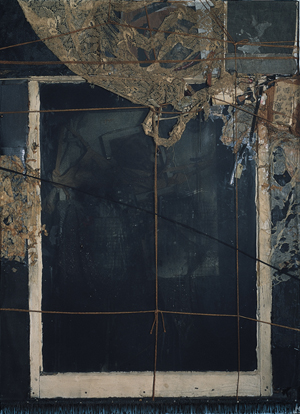Dark Visions: Mid-Century Macabre
On View:
September 2, 2016 - January 16, 2017
Release Date:
June 1, 2016

Pasadena, CA—The Norton Simon Museum presents Dark Visions: Mid-Century Macabre, an intimate exhibition that explores unsettling and thought-provoking works of art by some of the 20th century’s most influential artists, among them Bruce Conner, Joseph Cornell, George Herms and Edward Kienholz. The 15 works on view—comprising assemblage, painting and lithography—demonstrate the ways in which artists have portrayed humankind’s struggle to face death and life’s tribulations—whether through catharsis, psychosis or a portrayal of horrors.
While the works on view span media and decades, many share similar characteristics: the palettes are muted blacks and browns, space is restricted, and figures and forms regularly find themselves in boxes, or (even) include boxes themselves. These boxes suggest a chaos, a struggle to overcome the confines of the frame. With Lust Murder Box No. 2 from 1920–22, artist Kurt Schwitters hired master wood craftsman Albert Schulze to make a small box using intarsia—a wood veneer inlay technique—so that the work resembled his collages and the constructed overlaid forms of architecture in his famous Merzbau studio. According to Kate Steinitz, an early collaborator of Schwitters and donor of the artwork to the Museum, the title is based on a damaged plaster figure that once lay in the box and which the artist daubed with lipstick to make it look “bloody.”
Using more traditional materials, Jack Edward Stuck envisions himself as a silhouetted profile strapped into a gas chamber chair in his painting Self-Portrait from 1960–61. The viewer voyeuristically looks in through one of the portholes of the chamber to see the artist calmly awaiting execution. Stuck does not rely on an overflow of materials to impart a sinister feel. The flat handling of the paint and the faint pencil lines lend a disquieting sense of foreboding.
A more viscerally vicious act is depicted in the lithograph Combat from 1965, by Leon Golub. Here, two forms are intertwined in violence, as one combatant raises a fist over the other. The bold, slashing lines lend themselves to the frenetic pace and anxiety of the physical confrontation—so much so, that there is no delineation between one assailant and the other in this struggle for power. Golub does not hide anything from viewers; he puts this clash between two bodies front and center, forcing them to confront their own fears of brutality.
Other works of art in the exhibition include Jess’ illuminated Assembly Lamp Eight, 1966—a seemingly old-fashioned lamp whose shade is comprised of photographs and glass lantern slides; Conner’s HOMAGE TO MINNIE MOUSE, 1959, a dark and mesmerizing assemblage with decomposing architectural features and fabric; Kienholz’s The Secret House of Eddie Critch, 1961, an old writing-desk inhabited by dismembered doll parts and animal fur; and Connor Everts’ Now the Act Is Consummated from his seminal Studies in Desperation lithographic series of late 1963, created in part as a response to the assassination of President John F. Kennedy.
Dark Visions: Mid-Century Macabre is organized by Curatorial Associate Tom Norris. The exhibition is on view in the Museum’s main level rotating gallery from Sept. 2, 2016 to Jan. 16, 2017. A series of events will be offered in conjunction with the exhibition. Information can be found at www.nortonsimon.org.
About the Norton Simon Museum
The Norton Simon Museum is known around the world as one of the most remarkable private art collections ever assembled. Over a 30-year period, industrialist Norton Simon (1907–1993) amassed an astonishing collection of European art from the Renaissance to the 20th century, and a stellar collection of South and Southeast Asian art spanning 2,000 years. Modern and Contemporary Art from Europe and the United States, acquired by the former Pasadena Art Museum, also occupies an important place in the Museum’s collections. The Museum houses more than 12,000 objects, roughly 1,000 of which are on view in the galleries and gardens.
Location: The Norton Simon Museum is located at 411 W. Colorado Blvd. at Orange Grove Boulevard in Pasadena, Calif., at the intersection of the Foothill (210) and Ventura (134) freeways. For general Museum information, please call (626) 449-6840 or visit nortonsimon.org. Hours: The Museum is open Thursday through Monday, 12 p.m. to 5 p.m. (Friday and Saturday to 7 p.m.). It is closed on Tuesday and Wednesday. Admission: General admission is $20 for adults and $15 for seniors. Members, students with I.D., and patrons age 18 and under are admitted free of charge. The first Friday of the month from 4 to 7 p.m. is free to all. The Museum is wheelchair accessible. Parking: Parking is free but limited, and no reservations are necessary. Public Transportation: Pasadena Transit stops directly in front of the Museum. Please visit http://pasadenatransit.net for schedules. The MTA bus line #180/181 stops in front of the Museum. The Memorial Park Station on the MTA Gold Line, the closest Metro Rail station to the Museum, is located at 125 E. Holly St. at Arroyo Parkway. Please visit www.metro.net for schedules. Planning your Visit: For up-to-date information on our guidelines and protocols, please visit nortonsimon.org/visit. ![]() @nortonsimon
@nortonsimon![]() @nortonsimon
@nortonsimon![]() /nortonsimonmuseum
/nortonsimonmuseum
Press Contacts
Leslie Denk
Director of Public Affairs
(626) 844-6900
[email protected]
Emma Jacobson-Sive
(323) 842-2064
[email protected]
Press Kit
Request Images
High-resolution images from the exhibition may be obtained by emailing [email protected]
